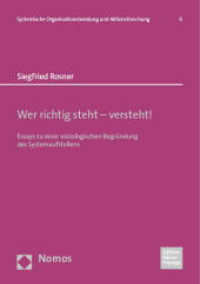- ホーム
- > 洋書
- > ドイツ書
- > Humanities, Arts & Music
- > Linguistics
- > english linguistics
Full Description
This book offers a range of perspectives and insights from around the world on the teaching and learning of listening, speaking, reading and writing. It brings together contributors from across six continents, who analyse a wide range of teaching and learning contexts, including primary, secondary, tertiary, private, and adult ESL/EFL classes. In doing so, they provide locally relevant accounts that nonetheless resonate with other contexts and wider concerns. This informative and practical edited collection will appeal to students and scholars who are interested in the four building blocks of language learning, as well as language education and teacher education.
Contents
Chapter 1. Teaching the four language skills: Themes and issues; Anne Burns and Joseph Siegel.- Part I. Listening.- Chapter 2. What teachers say about listening and its pedagogy: a comparison between two countries; Santos and Graham, United Kingdom and Brazil.- Chapter 3. L2 listening in China: An examination of current practice; Renandya and Hu, China.- Chapter 4. The development of a listening course for Japanese university students; McAuliffe and Brooks, Japan.- Chapter 5. Listening instruction for ESP: Exploring nursing education where English is a lingua franca; Tweedie and Johnson, Qatar.- Part II. Speaking.- Chapter 6. 'I can talk about a lot of things in the other language but not in English': Teaching speaking skills in Cameroon primary schools; Tante, Cameroon.- Chapter 7. Inquiry Dialogue: A genre for promoting teacher and student speaking in the classroom; Chappell, Australia.- Chapter 8. Teaching Dialogic Speaking Strategies in a Canadian EAP Program; Pang and Burri, Canada.- Chapter 9. Teaching Conversational English to Adult Learners via Skype: A Russian Perspective; Kozar. Part III. Reading.- Chapter 10. Supporting Elementary Students' Reading through Authentic Literature for Children; Vraštilová, Czech Republic.- Chapter 11. Teaching Reading to Encourage Critical Thinking and Collaborative Work; Murtiningsih and Hapsari, Indonesia.- Chapter 12. Reading Communities: Developing Autonomy through Community Building in an ESL Academic Reading Course; West, United States.- Chapter 13. Reading as Social Practice for Adult Immigrants: Talk around Text; Roach, New Zealand.- Part IV. Writing.- Chapter 14. Promoting Descriptive Writing through Culturally Relevant Literature; Hayik, Israel.- Chapter 15—Using Corrective Feedback on Writing to Enhance Vietnamese learners' autonomy; Pham and Iwashita, Vietnam.- Chapter 16. Promoting Self-Reflection in Writing: A Showcase Portfolio Approach; Lam, Hong Kong.- Chapter 17.'Localizing' second language writing pedagogy in a skills-integrated language program in Brazil; Villas Boas, Brazil.- Chapter 18. Future directions for the four skills; Joseph Siegel and Anne Burns.








